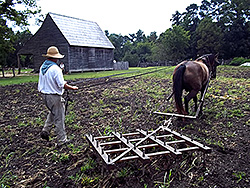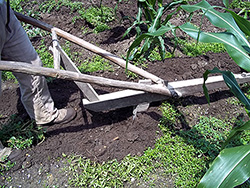Page content
Historic Farming
Primary Agricultural Implements
In a pre-industrial society most work was accomplished with hand tools, or those using muscle power. Agriculturally based economies therefore employed certain tools depending on the nature of crops produced. Because Virginia’s crops of tobacco and corn have Native American heritage, European settlers widely adopted Native American techniques of production, focusing on slash-and-burn land preparation, and “hoe-hill” production methods.
By far the dominant tool in Virginia during the 17th and 18th centuries was the hand hoe, in three basic forms. The narrow, or hilling hoe, possessed a long blade of about six inches width, connected to a homemade wooden shaft by a round “eye” attachment. It was predominantly used for creating the mounds upon which the plants grew and maintaining weed-free hills. Broad, or weeding hoes, were of similar construction, but up to 12 inches wide and classically used for shallow cultivation. Grubbing hoes were narrow and heavier in construction for the strenuous work of cutting and removing roots and stiff soils in land preparation.
Cultivation between hills was sometimes done with light-duty, single-horse “hoe” plows. Mattocks, axes, picks and spades also helped prepare ground for initial cultivation. Harvesting knives of unknown form, along with homemade baskets for transporting tobacco seedlings and dried corn ears, essentially complete the colonial inventory for tobacco and corn production.
Native American crop technology was complemented by the more complex European technology applied to small-grain production. Bar share plows pulled by horses or oxen prepared new seed beds by turning under weeds and surface material, exposing fresh soil. This rough surface was smoothed by dragging a harrow over it to make a finer-surfaced bed for the small seeds to take root.. And it was used to cover the seeds lightly, promoting seed germination and crop establishment. Harrows were wooden frames with iron spikes or wooden teeth to break down and comb the soil surface.
Small-grain harvesting tools included crescent-shaped hand sickles with fine cutting teeth, or smooth edged reap hooks of identical form. Sickles were used like hook saws, reap hooks cut the straw with a slashing action. At least one quarter of an acre could be cut, bound and stacked by one harvester per day. Scythes were also employed in harvesting grain crops. While larger, more expensive, and requiring more strength and skill to use, they were at the same time considerably more efficient in cutting the crop. Wooden-tined cradles were attached to the long-bladed, long-handled scythe to keep the straw parallel for efficient binding.
Threshing, or separating, technology included beating the grain heads with a flail (stick tied to a stick handle), or treading with horses on a circular packed earth threshing floor. The separated material was cleaned by passing it through a riddle (course sieve) on a breezy day, or by passing it through a winnowing or Dutch fanning mill. Such manufactured devices were the only real machines applied to agriculture before more important threshing machines were perfected during the early 19th century. Half-bushel measures were often used to measure the clean grain into sacks for local milling or five bushel barrels for export.


